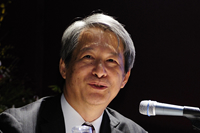A New Atlas on Global Value Chains - From Trade in Goods to Trade in Tasks (Panel Discussion)
October 19, 2011, (Wednesday)
National Graduate Institute for Policy Studies
(GRIPS) Soukairou Hall
>>Event Guide/Program
Organizers: IDE-JETRO, WTO
Supported by: National Graduate Institute for Policy Studies(GRIPS)
Keynote speech | Report 1 | Report 2 | Panel Discussion
パネルディスカッション
Moderator
Takashi Shiraishi (President, IDE-JETRO)
Panelists
Hubert Escaith (Chief Statistician, WTO)
Michitaka Nakatomi (Principal Trade Negotiator, Ministry of Economy, Trade and Industry / Senior Fellow, Research Institute of Economy, Trade and Industry (RIETI) )
Akira Kojima (Trustee & Senior Fellow, Japan Center for Economic Research (JCER))
Ganeshan Wignaraja
(Principal Economist, Office of Regional Economic Integration, Asian Development Bank (ADB))
Andrew Wyckoff (Director, Directorate of Science, Technology and Industry, Organisation for Economic Cooperation and Development (OECD))

Takashi Shiraishi
(President, IDE-JETRO)
Hubert Escaith (Chief Statistician, WTO)
A variety of facts became clear through measuring trade in value-added. The following is a rough overview. First, as indicated in the reports from Mr. Inomata and Mr. Degain, bilateral trade deficits and surpluses decrease when measured on value-added base. Second, because multiple transactions involving intermediate goods or services are counted in conventional trade statistics, there is a decrease in the monetary amount of trade within the region when calculated on value-added base. Third, we can gain a new perspective on the industrial competitiveness of a certain country. For example, when considering competitiveness in relation to the manufacturing industry of a certain country, the use of an input-output table highlights the role not only of the manufacturing industry, but of other related industries (service industries, etc.) as well. This allows us to see the industrial structure of that country that supports the competitiveness of its industries. Fourth, it is possible to analyze the degree to which an expansion of exports in a certain industry increases employment not only in that industry, but in other industries as well.
The third and fourth points are extremely important to policymakers and analysts. In short, if the competitiveness of domestic industries is dependent on imports from other countries, it is possible that domestic protectionist policies will actually weaken the competitiveness of that country. When establishing policy, policymakers must consider not only domestic industries, but also the economic interdependence that exists between countries.
Handouts (1.49MB)

Hubert Escaith
(Chief Statistician, WTO)
Michitaka Nakatomi
(Principal Trade Negotiator, Ministry of Economy, Trade and Industry /
Senior Fellow, Research Institute of Economy, Trade and Industry (RIETI) )
This report on the joint research conducted by the WTO and IDE-JETRO is an extremely accurate analysis, and is of the utmost value in understanding the history of economic and trade development in Asia, as well as the role that Japan has played. In addition, a significant number of readers have expressed their agreement with the assertion of “Made in the World.” I believe that the trade in value-added analysis technique is in the process of becoming established.
The first key finding of the report is the message that protectionism is meaningless, and that a system of free trade is necessary. Second, the report suggests the importance of supply chains. In addition, the report is valuable in that it clearly indicates the state of South-South trade and the increase of trade in intermediate goods. Finally, the report shows the history of economic development in Asia, allowing this experience to serve as a reference when considering economic development in other regions.
As for the implications of this report on trade policy, they are the same as the connectivity concept proposed by ASEAN. In short, in the future it will be necessary to strengthen connectivity, including creating a system, establishing and maintaining an infrastructure, and conducting exchange of personnel/human resources development. Japan currently has 13 FTAs, and is in negotiations with Australia and South Korea. ASEAN+3 and +6 are important as wide-area FTAs. In addition, an FTA with the EU is under consideration, and an FTA with Colombia is being researched. The future development of ASEAN+3 and +6 will have significant implications for Japan. The position that the Japanese government will take regarding TPP remains as an extremely important issue. In the future, Japan must move forward with both FTAs and the WTO to protect its national interests.
Next, when considering the relationship between international financial systems and international trade systems, this report from the WTO and IDE-JETRO has significant meaning. In particular, the report clearly shows the occurrence of the financial crisis, the shrinking of the market, the disruption of supply chains, and the damage to the economy. In addition, there is also the question of whether or not the WTO or the worldwide trade system has the strength to withstand the lengthy impact of the financial crisis on trade.
Finally, it is necessary to consider whether anything can be done in terms of policy. First, we can expect that this report will serve as material to facilitate an understanding of the danger of protectionism and the importance of the WTO and FTAs. Next, when considering policy, it will be helpful in sufficiently understanding the necessity of maintaining, strengthening, and developing global supply chains. In addition, based on a historical viewpoint, the source of an individual country’s competitiveness will shift, and a system for its creation will be required. Not only Japan, but other Asian countries are facing this same problem as well. Finally, it is necessary to study how to prevent problems in the trade system by learning how the financial system was altered by the financial crisis. In the 18 years since the Uruguay Round ended in 1993, the WTO has been unable to see significant results, so, in the future, it will be necessary to consider together how to create an international trade system, while listening to the needs of business and the views of industry.
Handouts (628KB)

Michitaka Nakatomi
(Principal Trade Negotiator, Ministry of Economy,
Trade and Industry /
Senior Fellow, Research Institute of Economy,
Trade and Industry (RIETI) )
Akira Kojima
(Trustee & Senior Fellow, Japan Center for Economic Research (JCER))
Today I would like to focus on Japan's stance, the ideal nature of Japan's policies, and issues of corporate management. Currently, Japan’s problem is that the interest and attention of companies and the stance of policies are extremely out of alignment in some cases. In the large flow of GVCs, there is a strong tendency for Japanese companies to venture out to external chains. Conversely, chains do not expand domestically. From the viewpoint of locational competitiveness, because corporation tax, employment systems, exchange rates, and other elements of corporate management decisions are currently moving steadily in an adverse direction, there is a fear that hollowing will occur, with high-value processes in the value chain being moved to the outside. It is a reasonable management decision for the company, but the gap with the operation of the national economy is growing. This is the problem of the Japanese economy.
For many years, Ricardo’s theory of competitive advantage was correct in explaining international trade in the era before the end of the Cold War. However, subsequent free movement of production elements, as typified by FDI, means that a competitive advantage is no longer given, but can be generated through policy. Ultimately, a “battle” between systems for creating a competitive advantage has developed globally since the end of the Cold War. Subsequently, the workings of world trade have changed dramatically, coinciding with the development of GVCs. Compared to the current trade friction between the U.S. and China, the trade friction between the U.S. and Japan in the 1980s was much more severe. At that time, the concepts of “Made in Japan by Japanese” and “Made in the USA by Americans” came into conflict.
The WTO was the first international trade organization to be born after the Cold War. Not surprisingly, its role in rapidly changing international trade is different from GATT in the past. For example, China’s FDI has now reached 1,860billion US$ indicating a current state of international trade that has been created by the direct investment of “Made in China by foreign companies.” Accordingly, trade in value-added should be discussed in addition to conventional trade statistics, and in fact, it actually seems rather late in coming.
Beginning in the 1990s, the world entered a period of major competition between systems that require locational competitiveness, and one after another we have seen the appearance of emerging economies that accept stimulation and production elements from the outside. In the midst of this movement, the stance of Japan's policies will be called into question. For example, regarding Japan’s FTA and EPA as well, discussions focus on ensuring opportunities for trade, and it is only infrequently that we see ideas to take in useful resources and production elements from overseas and once again revive Japan’s economic and social dynamics. Japan’s rate of acceptance of the entrance of companies from overseas is extremely low compared to the other OECD countries. Japan’s movement in GVCs is outward-looking. Currently, a variety of factors, including the impact of the earthquake, problems with the supply of electrical power, and the exchange rate, are accelerating the relocation of Japanese companies to overseas sites. Japan’s problem is a mismatch between policy and corporate management, in other words, between company’s “balance sheets” and the “balance sheet” of the national economy, and they are beginning to become more disparate in an era of globalization. Ultimately, healthy companies move offshore, increase revenue, and the value-added and employment that are generated go overseas. This is a significant contribution from Japan to China, but Japan must seriously consider how to respond in the future.
Our current era is one in which trade does not attract trade, but rather investment attracts trade. Investment changes the structure of trade and the system of division of labor. From another viewpoint, it is the development of GVCs. The Japanese government must take another serious look at the changes in the significant undulations of the era.
Finally, according to the World Investment Report, expectations are being directed toward non-investment-type international production networks as a method of development of new trade. Global economic activities will spread without movement of the ownership of capital. The issue is how the WTO and other organizations will reflect such new movements in statistics.
Handouts (1.45MB)

Akira Kojima
(Trustee & Senior Fellow, Japan Center
for Economic Research (JCER))
Ganeshan Wignaraja
(Principal Economist, Office of Regional Economic Integration,
Asian Development Bank (ADB))
The contribution of the current report from the WTO and IDE-JETRO can be summarized in the following three points. First, I believe that it has opened up a new aspect from which to view international trade systems. Second, it avoids the problems of double counting in the calculation of trade balances by adopting the concept of trade in value-added. Finally, it indicates a new point of view regarding international competitiveness, from the standpoint of policy. There are high expectations for future development, but much work remains.
My comments are as follows.
- Today the world is approaching a new era. It is also an era in which Asia cannot remain isolated from supply shock. It is said that supply shock may reach Asia in the future. Because the shock ripples through trade channels, it is necessary for policymakers and corporate management to deepen their understanding of GVCs in order to prepare for the coming crisis.
- South-South trade is vital in rectifying trade imbalances, and will be one road to economic growth. Much attention will likely be turned toward demand within the Asian region in the future. Trade between India and China, and between China and other parts of Asia will become increasingly important. It is believed that this will require three trillion dollars, due to the existence of a significant gap in the development and maintenance of the infrastructure. The spread of FTAs, etc., in Asia indicates deep integration, and it will become more comprehensive in the future.
- FTAs have contributed to Asia’s production networks. However, according to an investigation of the actual use of FTAs, only 30% of all companies use FTAs. However, it is also true that the usage rate has increased over past figures. In addition, the main users are major companies and multinational companies, and usage is still difficult for small and medium-sized companies. Insufficient information is a particular problem, including certificates of origin and non-tariff barriers, so the use of FTAs is insufficient. Corporate-level research regarding barriers is required.
- FTAs for the overall region include ASEAN+3 and ASEAN+6, and TPP is progressing concurrently. Goods, services, and investments are at the core of the ASEAN agreements, but TPP is more comprehensive, including policy related to areas such as competitiveness and government procurement. The issues of GVCs will be deeply connected to the state of trade over the next ten years, including, for example, the questions of whether or not China will join TPP and what will happen to Asian factories. However, a prediction is difficult due to the various points of interlock between politics and the economy.
- According to the results of our analytic simulation, Japan will receive the most benefit from TPP. In the medium term, Japan will obtain profit equivalent to 1% of its GDP. Rule-based trade and the liberalization of investment will benefit Japanese companies, but there may be some areas that will see a loss in Japan, such as the agriculture industry. However, gradual liberalization of these areas is also a possibility. Conversely, it has been shown that if Japan does not participate in TPP, there is a possibility of entering a period of long-term economic stagnation.
Handouts (146KB)

Ganeshan Wignaraja
(Principal Economist,
Office of Regional Economic Integration,
Asian Development Bank (ADB))
Andrew Wyckoff
(Director, Directorate of Science, Technology and Industry,
Organisation for Economic Cooperation and Development (OECD))
This report from the WTO and IDE-JETRO is wonderful, and has significant meaning for trade policy and political issues.
What we have learned from the report is that a high level of integration of the value chain is underway in Asia. In addition, it clearly indicates the importance of processing trade in China. Further, China’s economy has seen gains due not only to the availability of low-wage labor, but also significant factors including economies of scale and increased access to the international market through trade in intermediate goods.
The report indicates that when the bilateral trade balance is measured using trade in value-added, the results differ greatly from the conventional measurement of the trade balance. The outlook for trade in the future is that it is likely that the interdependence of each country will deepen through fragmentation between countries. Networks will become more intimately connected at a regional level. In addition, we can also see from recent research that protectionism is not only disadvantageous for neighboring countries, but damages the country engaging in such practices as well.
This report is an extremely good starting point, and there are many things that must be done in the future. Possible additional work includes, for example, an increase of the number of countries and consideration of the company’s capital configuration. In addition, when looking at the flow of capital, it is necessary to look at both tangibles and intangibles. Standardization of a 50-country input-output table is underway at OECD. I ask for your participation in this work in the future.
Further, as for international intra-firm trade, transactions involving not only goods but services as well are occurring frequently between head offices and their subsidiaries. Moreover, there is also a flow that consists of transactions involving intellectual property. Statistics related to whether the profits of subsidiaries remain with the investor or return to the home country are also important. An understanding of trade in services is particularly important, but currently there is a lack of statistics.
Moreover, regarding capital goods services, investment in intangible assets exists in addition to investment in tangible assets. One future issue is how these will be reflected in trade in value-added. In other words, a considerable portion that generated value-added is the contribution of capital that includes intangible assets. For example, if we look at the relationship between trademarks/licenses and GDP, we can clearly divide the developed world and developing countries groups. In addition, if we take the case of Apple’s iPod as an example, a considerable portion of the company’s revenue comes from iTunes. Because there are people who purchase an iPod because iTunes exists, we cannot disregard the contribution of intangible assets to value-added. It is particularly necessary to pay attention to the degree to which transactions will involve intangible assets in trade in the future.
By way of conclusion, it is likely that the development of GVCs will become more complex in the future. In addition, China will likely move forward with further high-level vertical integration, and close in on America and the EU. Regarding the measurement of trade in value-added, because the contribution of intangible assets is not clear, this may be one reason that the relationship between GVCs and RTA cannot be seen. Finally, what should be emphasized is that it is believed that intangible assets will be extremely important in the future in the promotion of growth strategy.
Handouts (501KB)

Andrew Wyckoff
(Director, Directorate of Science,
Technology and Industry,
Organisation for Economic Cooperation
and Development (OECD))
Keynote speech | Report 1 | Report 2 | Panel Discussion

